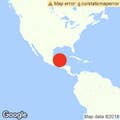
TAPACHULA, Mexico — More than 7,200 migrants undertook a brisk walk through the southern Mexican state of Chiapas on Sunday, defying threats from President Donald Trump to stop them and attempts by the government of Mexico to process people into the country individually.
The caravan began streaming into Tapachula, the migrants' resting place for the day, eight hours after it departed Ciudad Hidalgo — a 23-mile march under marathonlike conditions and 90-degree heat. People limped into the main plaza, took their shoes off, and lay down. Some fell asleep right away.
"Welcome to Tapachula!" Denis Contrera, a volunteer with Pueblo Sin Fronteras, the organization that had coordinated a caravan last spring, told the crowd. He told them to keep the place clean and stay on their best behavior.
Contrera said he felt like he could faint at any moment, and that people would need to rest for at least a day and a half after the trek. He added that people were skeptical about registering with Mexican authorities, who'd promised permits to remain in the country, because "if they have [the migrants'] information, so will the US," and it will complicate their entry there.
It was an unprecedented day in the annals of Central American migration as a stream of people took over the highway linking Ciudad Hidalgo with Tapachula. They filled one side of the highway, linking arms to form human chains as organizers in the group shouted for people to stay on the right side of the yellow dividing line.
A large contingent of federal police at one point had descended on the highway, but packed up and retreated as the caravan advanced, only to reassemble hours later farther up the highway. More than a dozen buses carrying uniformed men and women parked on the side of the highway, a police helicopter circled low over the marchers, and a police patrol car drove past the caravan. But there was no effort to stop the marchers' forward progress.
Immigration police commissioner Francisco Echeverria told reporters that authorities planned to channel the people to a shelter in Tapachula, where they would be allowed to wait while the Mexican government issued them permits to remain in the country.
Asked whether the migrants would be detained, Echeverria said no, but then gave conflicting statements: He said they would not be able to leave the shelter but then that they would be able to move freely within, but not outside of, the state of Chiapas, Mexico's most southern.
Some children were separated from their parents during the march. One of the volunteers organizing the march carried Kimberly Michelle on his shoulders. The girl was slumped over, beaten down by the heat. Toward the end of the caravan, some women were visibly struggling to keep up, and some were stumbling.
Saira Rivera walked near the front of the caravan, holding her 5-year-old daughter's hand. "I haven't had to carry her once," she said, proudly. The little girl, wearing purple-and-pink Crocs and with a rag tied around her head to protect her from the sun, was covered in sweat.
Rivera said she had not been able to find a job for three years in her native Honduras and that she had left behind a 10-year-old daughter who would not have had the strength to make the walk across Central America to Guatemala and now into Mexico.
The caravan is the second large movement northward of Central Americans this year to have captured Trump's attention, and it prompted a fresh wave of tweeted threats against the governments of Mexico, Honduras, Guatemala, and El Salvador.
It remains unclear how far the caravan is likely to travel into Mexico, though it is unlikely to reach the southern US border before voting takes place in the United States in critical midterm elections, now just two weeks away.
Trump had praised Mexico on Friday after police lobbed tear gas canisters at caravan members who had rushed the gate on the bridge that links Guatemala and Mexico. But on Saturday, police made no effort to detain the hundreds of migrants who abandoned the bridge in favor of the short raft ride across the Suchiate River, which divides Mexico from Guatemala. The game of retreat and reassembly that the police appeared to be playing with the march on Sunday seemed intended to deliver an image of toughness without actually provoking a confrontation. Trump's response was muted.
Full efforts are being made to stop the onslaught of illegal aliens from crossing our Souther Border. People have to apply for asylum in Mexico first, and if they fail to do that, the U.S. will turn them away. The courts are asking the U.S. to do things that are not doable!
A statement from Department of Homeland Security Secretary Kirstjen Nielsen linked the caravan to smuggling, though there was no sign smugglers were involved in the scene in southern Mexico.
“While we closely monitor the caravan crisis, we must remain mindful of the transnational criminal organizations and other criminals that prey on the vulnerabilities of those undertaking the irregular migration journey," the statement said. "We fully support the efforts of Guatemala, Honduras and Mexico, as they seek to address this critical situation and ensure a safer and more secure region.”
The caravan's sheer size was a startling development. A caravan last spring that first earned Trump's ire numbered no more than 1,500 people at its height, and last week estimates placed the new caravan at perhaps as many as 4,000 people.
But that number had swollen dramatically by the time the marchers set off Sunday, according to Chiapas state police.
Most of the marchers said they were fleeing their homeland because there are no jobs, especially for people over 30, and their lives are under constant threat from gangs. Many also expressed fears of government repression after a controversial presidential election last year.

